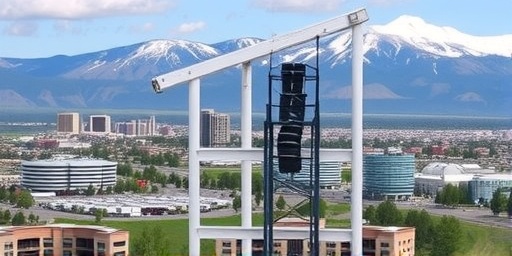In a stark indicator of economic strain, a recent poll conducted by the Colorado Economic Research Institute has uncovered that 68% of Coloradans are actively cutting back on non-essential spending due to escalating worries over the cost of living. This survey, released on Monday, paints a picture of a state grappling with inflation pressures that are outpacing wage growth, forcing families from the bustling streets of Denver to the mountainous regions of Aspen to rethink their budgets.
- Poll Uncovers Widespread Anxiety Over Inflation’s Grip on Daily Life
- Housing and Groceries: The Biggest Budget Busters in Colorado
- Consumer Habits Evolve: From Luxury Splurges to Essential-Only Purchases
- Expert Voices: Foreseeing Challenges for Colorado’s Economic Recovery
- Looking Ahead: Potential Relief and Long-Term Strategies for Coloradans
The poll, which surveyed over 2,500 residents across urban, suburban, and rural areas, marks a significant uptick from last year’s figures, where only 52% reported similar adjustments. As the economy in Colorado faces headwinds from national trends like supply chain disruptions and energy price hikes, local consumers are feeling the pinch acutely, with many citing housing and grocery costs as primary culprits.
Poll Uncovers Widespread Anxiety Over Inflation’s Grip on Daily Life
The findings from the poll highlight a pervasive sense of unease among Colorado‘s diverse population. According to the data, 74% of respondents expressed concern about the cost of living rising faster than their incomes, a sentiment echoed across age groups and income brackets. In particular, millennials and Gen Z residents, who make up 40% of the survey sample, reported the highest levels of stress, with 82% indicating they have delayed major purchases like home appliances or vehicles.
Dr. Elena Vasquez, lead researcher at the institute, commented on the results: “This isn’t just about numbers on a page; it’s about real families making tough choices. The economy here in Colorado is resilient, but the sustained rise in essentials is eroding that confidence.” Her words underscore the poll’s revelation that 61% of participants have reduced dining out frequency by at least 50% in the past six months, opting instead for home-cooked meals to stretch their dollars further.
Geographically, the survey showed disparities: Urban dwellers in the Front Range, including Denver and Boulder, reported the sharpest declines in consumer spending, with 72% curbing entertainment and travel expenses. In contrast, rural areas like the Western Slope saw 55% of respondents focusing cuts on utility bills, exacerbated by higher heating costs during harsh winters.
Housing and Groceries: The Biggest Budget Busters in Colorado
At the heart of the cost of living crisis, housing emerges as the dominant force driving consumer spending reductions. The poll indicates that median rent in Colorado has surged 15% year-over-year, pushing 45% of renters to seek roommates or side gigs to cover payments. Homeowners aren’t faring much better, with property taxes and maintenance costs contributing to a 38% increase in financial anxiety related to shelter.
Groceries tell a similar tale of restraint. Survey data reveals that the average Colorado household’s food budget has ballooned by 12%, prompting 67% to switch to generic brands or shop at discount stores. For instance, staples like milk and bread, once affordable cornerstones, now represent a larger slice of the pie, leading many to meal plan rigorously or forgo impulse buys at farmers’ markets—a tradition in foodie havens like Fort Collins.
- Key Statistic: 53% of families with children under 18 have eliminated extracurricular activities to offset grocery hikes.
- Regional Insight: In Colorado Springs, where military families abound, 49% reported cutting back on fresh produce due to price volatility.
- Trend Alert: Organic and local products, popular in eco-conscious Boulder, have seen a 29% drop in purchases per the poll.
These shifts aren’t isolated; they reflect broader economy pressures. The U.S. Bureau of Labor Statistics corroborates the poll’s findings, noting Colorado’s consumer price index rose 6.2% in the last quarter, higher than the national average of 5.8%. Experts attribute this to the state’s reliance on imported goods and tourism-dependent supply chains.
Consumer Habits Evolve: From Luxury Splurges to Essential-Only Purchases
The poll delves into evolving consumer spending patterns, revealing a pivot toward frugality that could reshape Colorado’s retail landscape. Notably, 59% of respondents have canceled streaming subscriptions or gym memberships, redirecting funds to necessities. Vacation spending, a boon for the state’s ski resorts and national parks, has plummeted, with only 32% planning trips within Colorado compared to 48% last year.
Retailers are taking notice. Sarah Thompson, owner of a Denver boutique, shared her perspective: “We’ve seen foot traffic drop 25% since summer. Customers who used to browse for trendy outfits now stick to basics or shop sales only.” This mirrors the poll’s data on apparel, where discretionary clothing buys fell by 41%, as Coloradans prioritize durable, weather-resistant gear over fashion statements.
Transportation costs also factor heavily, with gas prices averaging $4.50 per gallon statewide—a 20% jump from 2023. The survey shows 64% carpooling more or using public transit like Denver’s RTD system, reducing overall mobility spending by 35%. For outdoor enthusiasts, even hiking gear and camping supplies have taken a hit, with 47% postponing upgrades to existing equipment.
In a positive note for sustainability advocates, the poll highlights a silver lining: 28% of participants reported increased home gardening to combat food costs, boosting local seed sales and community-supported agriculture programs in areas like Pueblo.
Expert Voices: Foreseeing Challenges for Colorado’s Economic Recovery
Economic analysts are sounding alarms based on the poll‘s implications for Colorado’s economy. Dr. Marcus Hale, an economist at the University of Colorado Boulder, warns that sustained consumer spending cuts could lead to a 2-3% contraction in GDP growth for the state by mid-2024. “If this trend persists, small businesses— which employ 45% of Coloradans—will feel the squeeze, potentially leading to layoffs,” Hale stated in an interview.
The poll also touches on wage stagnation: Only 39% of workers reported salary increases matching inflation, fueling a cycle of reduced spending. In tech hubs like Boulder, where Silicon Flatirons drives innovation, even high-earners are tightening belts, with 51% forgoing professional development courses.
Comparatively, Colorado’s situation aligns with Western states but exceeds national averages. A parallel national poll by Gallup showed 55% of Americans cutting back, underscoring Colorado’s amplified vulnerability due to its high cost of living baseline—ranked 8th in the U.S. by recent indices.
- Policy Recommendations: Experts urge state incentives for affordable housing and energy rebates.
- Business Strategies: Retailers advised to offer value bundles to retain loyal customers.
- Consumer Tips: Financial advisors recommend budgeting apps tailored for Colorado’s unique expenses.
Governor’s office spokesperson, Lisa Chen, responded to the poll: “We’re monitoring these trends closely and exploring relief measures, including expanded tax credits for low-income families.” This signals potential legislative action to mitigate the cost of living burden.
Looking Ahead: Potential Relief and Long-Term Strategies for Coloradans
As the poll concludes its snapshot of current woes, forward-thinking strategies offer hope for Colorado’s residents. Economists predict that if federal interest rate cuts materialize by late 2024, mortgage and loan rates could ease, providing relief for the 35% of poll participants eyeing homeownership. Local initiatives, such as Denver’s proposed grocery tax holiday, could shave dollars off essentials, encouraging a rebound in consumer spending.
Community responses are already emerging. In Aurora, neighborhood co-ops for bulk buying have gained traction, helping 22% of surveyed families save on groceries. Education campaigns on financial literacy, backed by nonprofits like the Colorado Financial Education Center, aim to empower residents with tools to navigate the economy‘s volatility.
Long-term, diversification is key. The state’s burgeoning renewable energy sector could create jobs offsetting tourism dips, while remote work trends—embraced by 48% of respondents—might allow relocations to lower-cost areas within Colorado. As one polled resident from Grand Junction put it, “We’re adapting, not defeated. This poll is a wake-up call to build resilience.”
Ultimately, the path forward hinges on collective action: policymakers addressing root causes, businesses innovating for affordability, and consumers making informed choices. With Colorado’s natural beauty and innovative spirit, there’s optimism that these challenges can foster a more sustainable economy, turning cost concerns into opportunities for growth.









